#I can't believe it's finally done and posted
Explore tagged Tumblr posts
Text
Oops, forgot to block.
But anyways, it seems like you don't understand.
Let me put it like this for you.
You have been provided links with proof [that I'm sure you didn't even touch.] And instead of bringing up any point related to them you stick to your same arguments.
I asked you a simple yes or no question, and you seem to have taken it personally. It doesn't matter to me what you think the answer is, because the answer is always no. An infertile woman is just as much of a woman as any other. We are what we want to be. Your words mean nothing to me, and other peoples identity. [which let me remind you *again* that you've been provided links in the comments which explain this stuff better than I ever could]
[And let me tell you something. Just because we can't have kids right now doesn't mean it'll remain that way in the future. I believe that something will be figured out later in the future that will allow trans-people to be able to reproduce with their new reproductive apparatuses. Whether that takes years or decades doesn't matter. It'll happen.]
You used word meanings as "arguments". May I remind you that, words were created far before any research was done on this matter? [Not exaclty sure when or how much words change but I'm almost sure it's a pretty slow process, so they might be a bit or alot outdated. Not sure though.] And that maybe instead of etymology, you should be looking at psychology, and biology? [Links in the comments~] Trying to use words meanings as arguments doesn't really work out that well when we're not talking about words but people.
[And by the way. Where is your evidence? You've been provided links explaining this stuff, yet when pressed, you only choose to go to ... a dictionary? Really?]
[Also, since you've stooped into insults let me get in on that action.]
Why do you care so much? Like really. Why does this matter that much to you? Are you that miserable that the only joy you get is by hating on other people being themselves and happy?
Look, I know it's hard to find a purpose in life, or a job, but it'd be alot easier if you stopped being a prick and just let people be themselves. There's no reason to hate people who literally don't affect you in any shape or form. They're just being themselves. Cope. [Your final reminder that there are links in the comments!~]
Or do you just refuse to grow up and understand that it doesn't matter what you say. People will be themselves and happier than you will ever be?
I am not a debator. I'm just some angry penguin on the internet. I have left my piece here. And I won't forget to block this time. May this be the last time I see your miserable blog on my feed.
And for everyone else who comes across this post, trans or otherwise. Your identity is Valid. You know yourselves better than some stranger on the internet. Or anyone who's not you. Because it's Your Identity. Not these peoples.
Do not let the hateful words of bigots make you feel bad about youself. You are the only one who can choose your identity. Not some idiots on the internet. You. And let me say this again Your identity is always valid. No matter what others say. ❤️
Goodbye. 👋
[Even if you reply to this, I'm not wasting anymore of my time on you John. You've been given links, read them. The same goes for any asshole who wants to start another argument. I do not care for you. Find someone else to deal with your bullshit.]

Facts matter. #VoteBlue
2K notes
·
View notes
Note
i wanted to say your post about lu guang's morality is currently my favorite thing ever. im not sure if you're just incredibly smart or have the gift of prophecy but you are so right and the post is very very good
hi! i'm so glad you enjoy my post >.<
i tragically do not have the gift of prophecy, but i'm happy to explain my reasoning! spoilers ahead.
first off, i wanna say that when i made that post, it was less of a prediction and more of a reading of what the show had already laid out.
i've seen a few detractors of my post on twitter, all of them saying things along the lines of "this is a misguided take because lg is selfless. lg only killed vein bc vein killed csx. we have no proof that lg is sacrificing others." there's a lot to pick apart with these rebuttals, and i'll get to that, but i feel there is one essential point they are all missing: time travel in an of itself is an act of hubris.
going back in time with the intention of changing the past is one born out of great hubristic selfishness. anyone doing so is automatically (and wrongfully) assuming the role of a god.
the show is well aware of this. take the earthquake arc for example. as csx takes it upon himself to try and evacuate the village, lg points out that in doing so, he could end up inadvertently killing more people. this is because the butterfly effect is uncertain and lg knows this. that whole interaction functions two-fold. one: it establishes that the narrative itself is aware of the stakes here. it is an in-universe acknowledgment that changing the past, even if it's to save lives, is extremely risky and ultimately selfish. two: it establishes that lg is very aware of this truth, which is what makes the s2 reveal so shocking. despite being aware of the consequences, lg is still trying to change the past to save csx.
it also tells us that lg's steadfastness about csx not changing the past is likely born out of a fear of csx accidentally messing up the timeline lg is cultivating, and not out of some noble effort to minimize their impact on others' lives, which is how it was previously framed. all this evidence paints a very clear picture: lu guang is not the morally just character we once thought. he is placing his own happiness above literally everyone else's wellbeing. yes he is trying to save csx, but he's only doing that because he can't stomach the idea of living without him. his motivations are objectively selfish at their core.
back to the detractors: i feel some people are conflating lg's actions being done out of love for his actions also being selfless. and while i agree there is an (albeit twisted) form of love behind all this, there is nothing selfless about what he's doing. why does lg get to decide what the future should hold? why does any one man get the final say on what happens to the rest of the world, and all the billions of rich lives within it? hell, why does he even get to decide what happens to csx? yes he's acting under the pretense of saving csx, but does csx even want to be saved? would csx even be okay with what he's doing? i honestly don't think so. when csx believed lg had died, he contemplated using his powers to go back in time and save him, but ultimately decided against it because as far as he was concerned, lg wouldn't approve. he understands the potential chain reaction that comes from saving even one life because lg drilled it into his head. even if he is impulsive to a fault, at the end of the day, csx would never want to cause harm to others, especially not at this magnitude.
even if this effort to change the past/future fails, the fact that he was willing to take this massive risk in the first places says a lot about his priorities and overall character. while he probably doesn't actively want to sacrifice others, he absolutely will if it means keeping csx in his life saving csx.
in this most recent episode, just minutes before killing vein, he says to him, "do you know the butterfly effect? in a dynamic system, any subtle change in the initial conditions may lead to different outcomes. i've been thinking how to change a destined ending completely. if there is an additional point before this, an unchangeable point, what will happen? no need to fear the deviation. just let it happen more completely." lg killed vein partly out of revenge yes, but also to create another unchangeable node in the timeline. he is trying to secure csx's future by taking another life.
and none of this is even touching on how lg possessed a woman's body, which is a COMPLETE violation of her autonomy, to kill vein, knowing damn well she'd take the fall for his murder. lol.
so yeah. lu guang is (and always has been) a selfish, immoral bastard (she said with love), and the writers were very deliberate in setting that up.
there's so much more i could say on this but then this would get way too long, which it already lowkey is haha. thank you for the ask! i genuinely appreciate the opportunity to word vomit all this <3
#sympathetic =/= morally grey#link click#shiguang daili ren#link click spoilers#asks#ask#i forgot what tag i use for asks oopps.#i did this instead of working <3
57 notes
·
View notes
Text
Again, my fruity vamps










Marauders era vamp AU ( 3/3 for now ) :
Yay we’re done for now !! Here’s more lore
I'm back AND with the Jegulus fanart I've been on since November at that 🫢 ( posted on Insta the 12th of January )
I can't believe I was this slow just to finish this, but oh well. Also, my vamp AU is back !! I really liked the lore I came up with for this one, so I'm glad I could add a third fanart to complete it. I might do a wolfstar one too (I've got some vamp x vamp hunter stuff brewing for them, just gotta figure out what I want their dynamic to be like ).
Now, for this fanart in particular, I have to admit I kind of improvised the whole thing on a whim and just went with the flow afterwards ( there are so many plot holes in the overall story 😭 ).
In this, since Regulus and Sirius are vamp royalty, Reg having a relationship with James (who's very much human) isn't too pleasing for Walburga and Orion ( not to mention the fact that they're plain out homophobic, but yk). Thankfully for him, Regulus' friends already have a lot of experience when it comes to running away for romantic and other personal purposes 😌👍.
On James' end, it's not much better either. Since Fleamont, a retired vampire hunter, also happens to be closely tied to multiple vampire hunter families, James is kind of surrounded by people that would very much like to off Regulus and the Black family as a whole. But frankly, for James, the most complicated part is probably having to hide his feelings for Regulus from his childhood best friends, Remus and Peter, who are vampire hunters in training. Overall, it was sort of a relief for James when he finally managed to sort things out in order to create an escape for Regulus (honestly it's all thanks to Pandora and Lily be they were the passageway between the two ( Lily is James' fiancée if you didn't already know )). In the end, l'm not sure if I want to give them a happy ending or not, so I guess we'll see.
#the marauders#james x regulus#jegulus#james potter#starchaser#regulus black#james loves regulus#regulus deserved better#regulus being regulus#slytherin skittles#marauders#marauders era#dead gay wizards from the 70s
36 notes
·
View notes
Note
also, while i am here :D !!!
it’s a bit of a mystery, how doting sae gets when you’re like this — your bare thighs spread across his lap, weak fists pawing at his chest as you try to reach his mouth for a kiss that he seems content in denying you the pleasure of. when your brain is up, up, up… too high up to come back down, and your eyes are all starry and love-glazed. when orgasm after orgasm has been pulled out of you, evidently so, with how you’ve drenched the cotton of his sweatpants that he’s still kept on through all the time he’s spent catching up to your racing thoughts and striking them dull with his fingers knuckles deep in your pussy, his thumb painting delicate shapes over your clit. fucking you dumb.
“saeee…” you keen his name high in your throat, and, oh, it’s such a sweet sound. it’s so sweet, when you’re bumping his nose with yours in a gentle bunny kiss, slightly lidded eyes gazing up at him in a way so adoring that it nearly makes him crack a smile. nearly makes his heart melt. and it does. a little. enough for him to tug you closer to him along his lap until you’re chest to chest—dragging your folds along the length that remains hard and erect in his pants. you’re just too adorable like this, mind lost to the clouds and your countenance so sweet— he supposes he can indulge you just a bit. running his fingers through your hair, a small smile playing not on his lips, but his eyes. you can tell. you can always tell, after all.
you know itoshi sae best.
he slowly moves a hand from your hair, knuckles grazing down the side of your face, index finger lightly tapping over your bottom lip before he stops his hand at the top button of your— his— button-down that you still have on. your breath hitches at the contact, his forearm grazing over your pebbled nipples in the process. and it makes you even more dizzy, fall even more in love, and you can’t help but nuzzle a bit further into him, tilt your head in the same way he knows you do when you’re silently begging him for a kiss.
and then his lips curl into a ghost of a smile. his hands are soft, so soft on you, and he lets you lean in for a moment — until he pulls his head back, one of his hands moving to your jaw and keeping you in place. “not yet. stay still for me.” and you do just as you’re told, falling limp in his arms, heaving a pathetic sigh that makes sae grind his molars— not out of frustration, but adoration. “you’re a good girl.”
it’s whispered, and he inhales on the final word, making his voice sound the slightest bit shaky. like something tender. a secret. you’re unsure of its intentionality.
his fingers slowly begin to undo the first button, and then the second, third, fourth, watching as more and more of your skin is revealed, how dejected of attention your nipples appear to be. sae is no sadist, not when you’re as endearing and well-behaved as you are in this moment, and so he slips his hands beneath your open shirt, smoothing up your waist and over your shoulders to shrug the loose fabric off you. his fingers are chilled and leave a path of goosebumps in their wake, he doesn’t need to hear your petulant whimper to know that his touch is cold on you.
“your hands… they’re cold,” you shiver in his arms, squeeze your thighs around his hips, hug him close, fingertips digging into his biceps and leaving little crescent shaped manifestations of your love.
it’s cute. you’re cute. so fucking cute. and he scoffs, when he finds an apology bubbling at the back of his throat, when he catches himself wanting to kiss you silly and feed you his heart. but he bites his tongue; he knows you have it in you to wait a little longer for him to be all sweet on you.
���i know they are. but you’ll warm them right up, won’t you?”
COCO DO YOU KNOW WHAT U HAVE DONE TO ME BY SENDING ME THIS . i can't believe this . i can't believe i have to post this bc i'm scared tumblr will eat one of my asks again BUT I FULLY LOVED THIS SO MUCH THAT I WANTED TO KEEP THIS FOR ME LMFAOOO /lh I THINK THE WORST PART /J IS THAT U KNOW ME SO WELL. THIS IS SOOO POINTED. OKAY i am putting the rest of my reaction below the cut!!
you 🤝 me with being so so good for our blue lock men fr… THE OVERSTIMULATION?? THE WAY HE'S STILL DRESSED?? god drives me CRAZYYY w how he focuses all on us augh. OUGHALFJLDSAJFKDS. anw . yeah im so normal soooo normal. god i SHOULD'VE KNOWN this was coming w all the bombs you've been putting in inboxes smh!!! /lh I THOUGHT I WAS SAFE !!! coco writing tho omg you are such a brilliant writer my friend… truly i cannot believe i have received such a gift in my inbox… i am treasuring this forever. ANW.
"catching up to your racing thoughts and striking them dull" and how did u know i was an overthinking queen 🧍 THIS LINE IS WRITTEN SO BEAUTIFULLY. "your eyes are all starry and love-glazed" THIS IS SO GOOD. you really make him sound like he loves me in this i am gonna faint about it . HE THINKS IM ADORING??? the "you know itoshi sae best" line keeps me up at night ohmygod . why would u say that . now i am thinking about that all the time . me? 🥺 knowing itoshi sae best? 🥺 hell yeah i do ohmygosh. heart in my hands head in my hands
AND WE'RE WEARING HIS SHIRT HELLO??? ohmygod i'm so in love w him . i can't believe you wrote him so in love w me. i feel so blessed it's crazy . i am so in love w him . ohmygod AND THEN HE TEASES US … THE ALMOST KISS… U WRITE tension so well i am SCREAMING. and we're nuzzling into him 🥺 that was sooo pointed and specific to me omg… one of my tells w the people i love fr… i don't think there's any way u could've known that so i am just o)-( about it
AND HE'S SO SOFT ON US. AND WITH THE FIRM TOUCH ohmygod. i need to take a lap. AND WE'RE GOOD FOR HIM… uwahhhh i am a puddle on the floor… i love him so much… i wanna be good for him so bad… AND THEN HIS VOICE IS SHAKY?? IS THAT US.. HAVING AN EFFECT ON HIM… UR KIDDING. GOD COCO THIS IS SO GOOD . WHY IS THIS IN MY INBOX GIRLLL POST IT AS A FIC U COULD BE GETTING NUMBERS !!! i can't believe this is for me . i am going to collapse on the floor
endearing 🥺 well behaved 🥺 WHAT ARE YOU DOING TO ME RN !!!!! ARE YOU IN MY WALLS !!! "crescent shaped manifestations of your love" UR WRITING DOES SMTH LIKE A REWIRING TO MY BRAIN. GOD THATS SO GOOD. WHY DOES HE SOUND LIKE HE LOVES ME . IT IS MAKING ME MELT I AM GOING TO SOB . "and feed you his heart" WAHHHHH MY FOREHEAD IS ON THE TABLE . "he knows you have it in you to wait a little longer for him to be all sweet on you" girl what if i collapse rn . ohmygod i need a cold shower . I AM SO FULL OF LOVE ABOUT THIS AND THIS IS SO HOT AT THE SAME TIME ??? THIS IS SO PERFECT ??? COCO??? I WOULD CARVE A PART OF MY HEART OUT FOR YOU . I AM SUCH A SAPPY HEATED MESS ABOUT THIS. cocofriend i am so ride or die for you fr u have no idea. I CAN'T BELIEVE YOU SENT ME THIS?? JESUS ohmygod i need to breathe . wahhhh i love him so bad . you have done a number on me with this . i love you so bad. ily so so much like i can't believe this was in my inbox and now this is gonna be on my blog like i wanna frame this and put it on a wall . what did i do to deserve this omg . i have been soooo blessed fr. i feel so loved w this like i feel so loved with this (from both you and how sae is in the fic) it is making me so sappy wahhhh
i love you . i have been rendered speechless now i am going to reread this forever and ever WAHH THANK YOU FRIEND… ALSO U BETTER WATCH OUT… HRMPH !!! I AM COMING FOR YOU
#long post#coco i have no words for what you have done to me . NO WORDS#I AM SO FULL OF LOVE FOR YOU . LIKE A WARM BELLY OF SOUP . THIS MEANS SO MUCH TO ME U HAVE NO IDEA...#i love you and i appreciate you dearly. i am your friend forever#message in a bottle: ask#message in a bottle: cocofriend!!!#fragments of memories: selfship#submerge and awaken: sae#<- this is canon in my selfship now btw
25 notes
·
View notes
Text

Looking back at this comment is so funny to me. I can't believe how proud I was of 80 hours on one of my first drafts. Like, I got ahead of myself so many times through this. I promoted it in tiktok comments for a while and shared excerpts on my old tumblr account, thinking I would be done way sooner than I was. I took a really hard fucking hit when I knew I was on the right track with my last draft and I was forced to watch it all crash and burn because I posted before working out the kinks.
When I made this comment, I had no idea the sheer amount of effort that would end up going into this. I don't think I would have had the heart or the patience to keep going if I had known. But I'm so grateful that I persisted through the embarrassment of a few failed starts. The final product is a thousand times better than anything I could have even fathomed coming up with a year ago.
This curse of a fic is my baby. It's my everything (besides my cats). Keeping a level head around sharing it is so difficult, but I have definitely learned my lessons when it comes to jumping the gun on putting my work out there lol.
#its not going to be for everyone#i can confidently say that#but im not writing it for the people who wont resonate with it#i wont be posting exerpts this time around because I dont want people to get the wrong idea of it#its absolutely brutal#i dont shy away from some really difficult and fucked up topics#but i will be yapping about it#raven neil#all for the game#aftg#neil josten#jean moreau#andrew minyard#the sunshine court#fanfiction
24 notes
·
View notes
Text
kpop idol au yuzuha x fem idol!reader (Part 2)
jesus christ there's not a lot of you but i expected like two people to read my rambling BUT IM GLAD THE FEW OF YOU THAT READ IT ACTUALLY LIKED THE KPOP IDOL YUZUHA so here's more !!
part 1

i can't keep calling the character's members of your group/your group member/yuzuha's group members, so we need to give them names!!!
... i sat here for like 5 minutes i can't think of group names SO let's just move on to member's names lmao (feel free to give me group name ideas!)
your group members:
you
eunjung
sunhee
miyoung
hyunjae
yuzuha's group members:
yuzuha
haeun
haejung
yunhee
kyungmi
ok now that that's out of the way
your fans love it when you and yuzuha's groups make a comeback at the same time cuz that means they get sooo much interactions during the promotion era.
like music shows are so fun. the fans and shippers are so well fed bc you and yuzuha are (suspiciously) close with each other, the amount of photos and videos you have together are endless. and i haven't watched these in a while but you know when idols like vlog themselves for their youtube channel? yeah, best believe yuzuha will always appear on your group's channel and vice versa.
"oh, and there's y/n," sunhee says, panning the camera over to you. you were eating a snack while getting your hair done before your performance. looking over to the camera sunhee held, you did a little wave. then someone else's head pops into view, "yuzuha is here too for some reason," sunhee snickers, knowing exactly why she's here.
"hey, guys! lemme borrow y/n for a sec, okay?" yuzuha grins, waving at the camera.
username01: sunhee sounds like she knows something we dont
→ username02 replied: it's like i can hear her smile from behind the camera lmao
also, don't forget the tiktok challenges! with every comeback, each of your group's fans are always always expecting the two of you to make tiktoks with each other's new songs.
username01: chat it's been days why haven't we gotten a single y/nzuha tiktok challenge
username02: if we don't get y/nzuha doing each others' tiktok chalenges i will seriously end it all
username03: my theory is that y/n and yuzuha fought over something so it's taking them long to make a tiktok
→ username04 replied: NO WAY they were interacting just fine on the recent show
→ username05: you may never know, idols are good at faking smiles
yet here you sat with yuzuha on the inkigayo stairs, laughing together when she showed you the comments your desperate fans were making.
"oh my god, you're right! they literally expect it from us now," you say in between laughs. it's no wonder this was how fans reacted—i mean, you two were always one of the first to post tiktok challenges. so you purposely tried to mess with the fans by giving them absolutely no content this time around to see if they'll notice.
and like, what were you expecting? of course they'll notice!
y/nzuha shippers are the worst because they genuinely feel like their ship is real. like gayer and realer than any other kpop ship out there, and you and yuzuha feed into it so much. even though you were rivals, this shipping thing is actually beneficial to both of your groups. almost all of your group's fans are also fans of yuzuha's group and vice versa bc of your ship. your duo with yuzuha is even more popular than the duos in your respective groups.
ok anyways, so you and yuzuha finally get up and decide to make some tiktoks together and you decided—after depriving your fans of y/nzuha content, you were going to release ALL the tiktoks you made that day. two of them were your group's respective tiktok challenges, then there was like one thirst trap, two of the tiktoks were like those couple trends—yes your fans went crazy and that is an understatement, and then another random tiktok dance challenge.
username01: they disappear for days AND THEY COME BACK WITH A FEAST
username02: y/nzuha nation, how does it feel to suffer from success?
username03: what the FUCK i was literally just talking about y/nzuha doing this chalenge AND THEY ACTUALLY DID IT... y/n or yuzuha has got to be my oomfs
→ username04 replied: y/n is more likely to be oomf methinks
username05: Y/NZUHA THIRST TRAPPING ON THE OFFICIAL ACCOUNTS SOMEBODY HOLD MY HAND
both you and yuzuha lurk on social media a lot and it's to see the fans reactions to basically anything, you're both hardworking idols—seeing what the fans like and absolutely milking it—in this case, y/nzuha. it's just a cute thing at first like "aw look, yuzuha and y/n used to be on that traumatizing survival show and they're still hanging out and really good friends."
and then it started getting serious like you weren't just a duo anymore, you're a ship. well, you have been since the survival show but with your debuts, you both started getting more fans and as a result, more shippers.
the both of you just look at each other, already plotting different ways to make fans go crazy. your managers had to stop you guys from posting a really really suggestive thirst trap one time, even your members have to give you guys warnings every now and then like you two better cool it!
you also have known for a while now that views aren't really authentic anymore in the kpop industry because of the streaming stuff. your rivalry with her doesn't really show when they announce winners at a music show. but your fans do get a bit of nostalgia when you guys post content together.
username01: this video of yuzuha and y/n is literally just them trying to outsing each other
→ username02 replied: if they ended up in a group together, we could've gotten another girls generation song where every vocalist outsings the other
→ username03 replied: ACTUALLY THO cant we just merge their groups? can they collab already?
or like you know how sometimes, you don't see idols putting in that much energy into each other's tiktok challenges? (no shade btw)
yeah, that could never be you and yuzuha. in every video, fans have noticed you guys have to glance at each other while dancing. giving looks that say "i'm doing your choreo better than you are."
oh your rivalry would also show in variety shows. there isn't really any room for rivalry in terms of music and popularity 'cause you can hardly control how fans view you and if anything, you both are always so supportive of each other's careers. so when you get a chance to go against yuzuha, you take the damn chance.
variety shows are definitely nostalgic for the fans 'cause you two refuse to team up with each other for games unless you were assigned to the same team. fans eat it up so much, there would be so many clips going around on tiktok, instagram and twitter.
while we're on the topic of rivalry, ISAC is a big day for y/nzuha nation.
when everyone finds out yuzuha was the head of the kyūdō club in high school, they're immediately expecting her to win in archery. but you practiced longg and hard to go against her.
now imagine the fans reactions when they find out yuzuha herself helped you train for ISAC lmfaooo
i think that's all the rambling i have for now but here's a bonus: new fans or non-fans of your groups mistake your ship name for y/n x kazuha of le sserafim instead of yuzuha and it's the funniest day on twitter ever. y/nzuha stans attacking them for not knowing it's yuzuha and all 💀
you share a selfie with kazuha after that day for funsies. let's just say, you kinda... sorta... maybe started a little fanwar. but y/n x yuzuha shippers aren't the only ones getting a little jealous. :)
#tokyo revengers#tokrev#tokrev x reader#tokyo revengers x reader#tokyo rev#tokyo rev x reader#yuzuha shiba#shiba yuzuha#yuzuha x reader
23 notes
·
View notes
Text
come back (even as a shadow, even as a dream) [12/12, complete, 113k]
pairing: Ava/Beatrice (Warrior Nun)
rating: M
chapter word count: 2.2k
chapter summary: Epilogue - Bea
Amsterdam is beautiful.
The bells of a nearby clocktower ring out, and the off-kilter melody they produce makes Bea smile. She leans forward, resting her weight on her elbows as she stands on the bridge, the wooden railing probably leaving indents in her forearms. She’s been waiting a while, has heard the bells chime out at least twice while watching boats drift lazily through the canal below.
full fic summary:
Three months after Ava disappears into the portal, Beatrice still can’t let her go. She’ll do anything to bring Ava back. But when she manages to succeed, the question is what else has Ava brought back with her? or Ava comes back wrong
total word count: 113k
IT'S FINALLY COMPLETE!!!
prologue - Bea chapter 1 - Bea chapter 2 - Bea chapter 3 - Bea chapter 4 - Bea chapter 5 - Ava interlude - Ava chapter 6 - Bea chapter 7 - Bea & Ava chapter 8 - Bea & Ava chapter 9 - Bea & Ava epilogue - Bea
(read on AO3)
#avatrice#ava x beatrice#warrior nun#ava silva#sister beatrice#fanfiction#fic: come back#I can't believe it's finally done and posted#I started writing this exactly 5 months ago#I really hope you enjoy#and if anyone has been holding off reading - it's safe to read it now lmao
249 notes
·
View notes
Text






IT'S HERE!!!
The digital English translation of my first published comic is up and available for purchase!
The comic "Break what fate builds", draws inspiration from historical events from the 12th century and motifs from the Byzantine Empire that ruled these areas. Through the characters' eyes, this story focuses on the relationship of young people within the Balkan & their home, distortions of identity, things long lost and much more.
You can get the digital version of Volume 1 here (available in both English and Macedonian) <3
see you for volume 2!!!
#can't believe im finally posting this. any boosts and love is appreciated aaaaaaaaaah#comics#original art#artists on tumblr#comic books#balkan blogging#thank you to everyone that's stuck around while I've been MIA working on this! it felt like a gigantic effort but it's done now#for anyone that's here for my mc:tna art- this was Heavily inspired by that drama since i began concepting for this story 2 years ago#so this might be something that could float ur boat ^^
174 notes
·
View notes
Text
cry for judas | the mountain goats
a bj hunnicutt character study vid
youtube link
Lyrics:
Some things you do just to see How bad they'll make you feel Sometimes you try to freeze time 'Til the slots are a blur of spinning wheels
But I am just a broken machine And I do things that I don't really mean
Long black night, morning frost I'm still here, but all is lost
Speed up to the precipice And then slam on the brakes Some people crash two or three times And then learn from their mistakes
But we are the ones who don't slow down at all And there's nobody there to catch us when we fall
Long black night, morning frost I'm still here, but all is lost
Feel the storm every night, hope it passes by Hallucinate a shady grove where Judas went to die
Unfurl the black velvet altar cloth Draw a white chalk Baphomet Mistreat your altar boys long enough And this is what you get
Sad and angry, can't learn how to behave Still won't know how in the darkness of the grave
Long black night, morning frost I'm still here, but all is lost
#mash#fanvid#bj hunnicutt#the mountain goats#my vids#m*a*s*h#can't believe how far i've come from sitting on a vid for weeks or months before finally deciding to post to just yoloing it as soon#as i'm done#well i finished last night and made a few tweaks today but yeah that's nothing compared to how i used to be lol#but like idk i think it's good as is
132 notes
·
View notes
Text

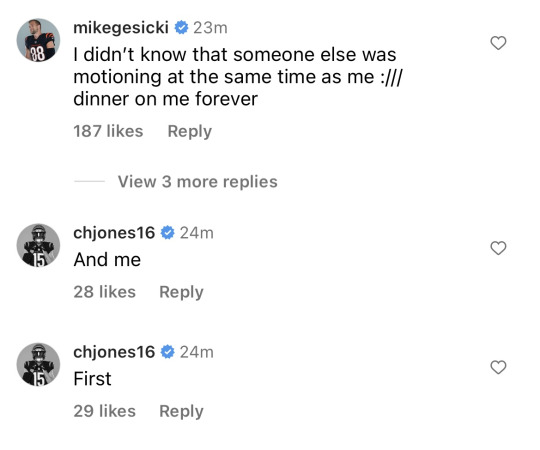
Dinner on me forever 🙃
#and charlie with the 'and me'#truly an insufferable group of grown-ass men i adore them#can't believe mike took that beautiful TD away from yoshi like that :( GET SET!!!#they both still had amazing games though <3#ALSO have we celebrated ja'marr finally following/interacting with yoshi on socials yet?#i have the memory of a goldfish but this feels new#i know some of you keep excellent track of such things. let me know.#ja'marr also hearted a comment of yoshi's on HIS post today so.#respect/love/affection FINALLY earned?? hard fought. well done yoshi.#andrei iosivas#mike gesicki#charlie jones#cincinnati bengals
35 notes
·
View notes
Text

I finally did it! I did it and made an illustration based on all of Taylor's Swift Eras Tour as Knights!!
Little backstory: Back in June,while I was still working on my Barchelor's Degree and in a frustration episode, I decided to make a fanart of Taylor Swift's eras yet again!(last year I have done that aswell,but it was done in the eras poster rather fashion ).
But I wanted to elevate the fanart and do something different this year,so I decided to make Alef Vernom's Eras Knights! (for those that don't know him,he is an artist that draws Taylor Swift fanarts and sometimes with other celebrities too,more popular and active on instagram and twitter,or used to until it got banned in Brazil,the country he is native from) Plus I wanted to do a fanart of his knights for a while now because I just loved his designs for knights and I discovered him exactly in the period he was creating them so I assisted like in real time as he was creating the design and putting stories on instagram along the way.
And so,I decided and dared myself to make a full illustration of the 11 knights of the Eras. At first I tought it'll take me max of 1 week maybe- and then I'll finish it. Of course,that did not happen because your calculations do not fit with those from the market( a little Romanian proverb that basically means that what you planned at first is not going to actually work up until the end xd) and as I was creating them... I finished college,sustained and passed my Barchelor's degree, entered at masters and a whole summer passed.
Not going to lie it was a hard ride,but it was a fun one. What started as a project that was a little idea of a fanart became a summer of frustration, blood,sweat and tears; alongside a rollercoaster of emotions. But here it is and I hope you like it as much as I also loved making it :) <3
CLOSE UPS:









#taylor swift#the eras tour#the eras knights#digital art#my art#art#borreall art#fanart#illustration#sooo this should've been just a silly project but no#i also had to film the whole process#because yes i also filmed the process and posted them on tiktok#guess this is from where the furstrstion came from#but nontheless now it is done#i can't believe is like i lived 4 lives since i started doing this illustration#i can finally sleep at night that i finally finished it#no more nightmares and hallucinations!! yipee#uhhh yeah anyway#i don't know what more tags to put anyway sooo#uhhh#cheese#idk#artists on tumblr
20 notes
·
View notes
Text

the reckless hearts
pairings: michael clifford/calum hood, michael clifford/harry styles (temporary), alex gaskarth/jack barakat, assorted minor pairings
rating: T
total word count: 53.7k
important tags: summer camp support staff AU, strangers to friends to lovers, ensemble fic, friendship, fluff, angst, hookup culture, bittersweet ending, galaxy hair michael
warnings: N/A
summary:
“And you’re what?” Michael asks, before giving Calum a once-over. “Logistics, I bet.” Obviously Michael hadn’t been tuned into his surroundings when Calum had given his brief introduction. “Yeah.” “Mike, I literally told you about Calum,” says Alex. “Did you?” Michael asks. Understanding dawns on his face. “Oh, you’re Calum, Alex’s roommate.”
-
(Or: summer camp AU, but make it support staff.)
Well. Here it is. The big ensemble summer camp fic I've been writing for over three years. This is the longest fic I have ever written. It is my passion project and my beloved child. Enjoy.
CHAPTER I // CHAPTER II // CHAPTER III // CHAPTER IV // CHAPTER V // CHAPTER VI // CHAPTER VII // CHAPTER VIII // CHAPTER IX // CHAPTER X // CHAPTER XI // CHAPTER XII // CHAPTER XIII // CHAPTER XIV // CHAPTER XV // CHAPTER XVI // CHAPTER XVII
#michael clifford#calum hood#malum#malum fic#5sos#5sos fic#fic#my fic#oh my fucking god finally#i started this fic over three years ago#almost three and a half#i can't believe it's actually done and i'm actually going to post it and it's actually fucking 53k#it is the longest thing i've ever written and absolutely a labor of love#i have so many fucking things to say and thoughts and feelings i JUST#i don't even know where to start#maybe ill start by saying that all the non-boy pictures in this moodboard are real photos of my own summer camp taken by me#(YES! IT REALLY IS THAT BEAUTIFUL!!!)#summer camp is a magical place you guys don't even know you CAN'T know unless you go#but i hope this fic shares that feeling with you all a little bit#auuughghhhhh im so nervous and stressed! but im doing it anyway!! fuck it we ball!!!#fic posting at 11:20pm is so me#stuff#trh#fic mb#my mb
18 notes
·
View notes
Text
What's the average language like?
This will be a giant of a post, because this is a subject that I really like. So much of what we think about language just isn't true when you look at the majority of them and I'm not even going into how the languages themselves are constructed, only the people speaking them, if that makes sense. It will make sense in a moment, I promise
First, let's discuss assumptions. When you think of the abstract idea of a language, what do you imagine?
How many speakers?
Where is it spoken geographically?
Do speakers of the language only speak that language or do they speak at least one other language? How many more languages?
Is the language tied to a state/country?
Is the language thriving or endangered?
In what domains is the language used? (home, school, higher education, administration and politics, in the workplace, in popular media...)
Is the language well documented and supported? Are there resources like dictionaries to look up words in, does google translate work for it, does Word/google docs work etc?
Is the language spoken or signed?
Is the language written down? Is it written down in a standardised way?
Do you see where I'm going with this? My perspective on what a language is has completely shifted after studying some linguistics, and this only covers language usage and spread, not how words and grammar work in different languages. Anyways, let's talk facts. (if no other sources are given the source is my uni lectures)
How many speakers does the average language have?
The median language has 7 600 native speakers.
7 600 people is the median number of speakers. Half the world's languages have more, half have less.
Most languages in this tournament have millions of speakers. But maybe that's relatively common? After all, half of the world's languages have more than 7 600 speakers. No.
94% of all languages have less than a million speakers.
Just so you know, big languages are far from the norm. There are 6700-6800 living languages in the world (according to ethnologue and glottolog, the two big language databases. I've taken the numbers for languages having a non-zero number of speakers and not being classed as extinct respectively. Both list more languages).
6% of 6700-6800 languages would be around 400 languages with more than a million speakers. Still a lot, but only a (loud) minority. It's enough to skew the average number of speakers per language upwards though. Counting 8 billion people and 6800 languages, that's almost 1.2 million people per language on average. The minority is Very loud.
Where are most languages spoken?
First of all, I'll present you with these graphs (data stolen from my professor's powerpoint) which I first showed in this post:
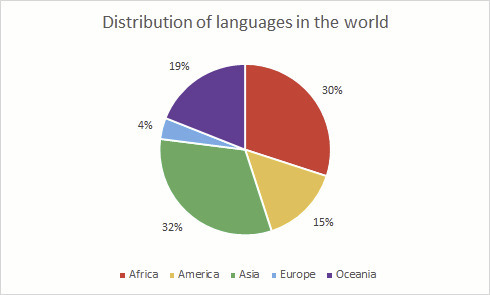
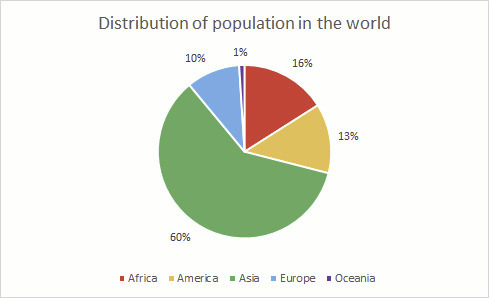
49% of all languages are spoken in Africa and Oceania, a disproportionately large amount compared to their population. On the other hand, Europe and Asia have disproportionally few languages, though Asia still has the largest amount of languages. Curious, considering Europe is often thought of as a place with many languages.
Sub-Saharan Africa is a very linguistically interesting place, but we need to talk about New Guinea. One island with 6.4 million people. Somehow over 800 languages. If you count the surrounding islands that's 7.1 million people and 1050 languages. Keep in mind that there are 6700-6800 languages in the world, so those 1050 make up more than a seventh of all languages. The average New Guinean language has less than 3000 speakers. Some are larger, but still less than 250 000 speakers. Remember, this is a seventh of all languages. It's a lot more common than the millions of speakers situation!
So yeah, many languages both in and outside New Guinea are spoken by few people in one or a few villages. Which is to say a small territory. But 7600 speakers spread over a big territory will have a hard time keeping their contact and language alive, so it's not surprising.
Moving on, lets talk about...
Bilingualism! Or multilingualism!
Is it common to speak two or more languages? Yes, it is. This is the situation in most of the world and has been the case historically. Fun fact: monolingual areas are uncommon historically and states which have become monolingual became so relatively recently.
One common thing is to learn a lingua franca in addition to your native language, a language that most people in the area know at least some of so you can use it to communicate with people speaking other languages than you.
As an example, I'm writing this in English which isn't my native language and some of you reading this won't have English as your native language either. Other examples are Swahili in large parts of eastern Africa and Tok Pisin in Papua New Guinea (the autonomous state, not the entire island).
Speakers of minority languages often have to learn the majority language in the country too. It's difficult to live somewhere where most daily life takes place in one language without speaking at least some of it. This is the case for native people in colonised countries, immigrants and smaller ethnic groups just to mention a few situations. All countries don't have majority languages, but some are larger, more influential and used for things like administration, business and higher education. It's common for schooling to transition from local languages to a larger language or lingua franca in countries with many languages.
Another approach than the lingua franca is learning the language of villages or towns surrounding you, which is very common in New Guinea and certainly other parts of the world too. It's not unusual to know multiple languages, in some places in sub-saharan Africa people speak five or six languages on a village level. Monolingualism is a weird outlier.
Speaking of monolingualism, let's move on to...
Languages and countries
This is a big talking point, mostly because it affected my view of language before I started thinking about it. First of all, I'm going to talk about the nation state and how it impacts languages within it and the way people view language (mostly because it's a source of misconceptions which fall apart as soon as you start to think about them, but if you don't the misconceptions will stay). Then I'll move on to countries with lots of languages and what happens there instead.
So, the nation state
The idea is that the people of a nation state share a common culture, history, values and other such things, the most important here being language. We can all agree that this type of nationalism has done lots of harm to various minorities and migrants all over the world, but it's still an idea that has had and still has a big impact on especially the western world. The section on nation states will focus on the West, because that's the area I know enough about to feel comfortable writing about in this regard.
How do you see this in common conceptions of language? It's in statements and thoughts like this: In France people speak French (but what about Breton? Basque? Corsican? Various Arabics? Some of the other 15 indigenous and 18 non-indigenous languages established in France? What about people speaking French outside of France?), in the US people speak English (but what about the 197 living indigenous languages? Or the 34 established non-indigenous languages? And the many extinct indigenous languages forcibly killed by the promotion of English?).
In X country people speak X, except for the people who don't, but let's ignore them and pretend everyone speaks X. Which most might actually do if it's the single national language that's used everywhere, it's common to learn a second language after all.
This is of course a simplified (and eurocentric) picture, as many countries either have multiple national languages or recognise at least some minority languages and give them legal protection and rights to access certain services in their languages (like government agency information). Bi-/multilingual signage is common and getting more common, either on a regional or a national level. Maybe because we're finally getting ready to move on from one language, one people, one state and give indigenous languages the minimum of availability they need to survive.
I wrote a long section about how nation states affect language, but I realised that veered way off topic and should be its own post. The short version is that a language might become more standardised simply by being tied to a country and more mobility among the population leading to less prominent dialects. There's also been (and still is) lots of opression and attempts to wipe out minority (often indigenous) languages in the name of national unity. Lots of atrocities have been comitted. Sometimes the same processes of language loss happen without force, just by economic pressure and misconceptions about bilingualism.
What does this have to do with the average language?
I simply want to challenge two assumptions:
That all languages are these big national languages tied to a country
That it's common that only one language is spoken within a country. If you look closer there will be smaller languages, often indigenous and often endangered. There are also countries in the West where multiple languages hold equal or similar status (just look at Switzerland and its four official languages)
Starting with the second point, let's take a look at how Europe is weird about language again
Majority languges aren't universal
I'm going to present you with a list of the 10 countries with the most living languages, not counting immigrant languages (list taken from wikipedia, which has Ethnologue as the source):
Papua New Guinea, 840 languages
Indonesia, 707 languages
Nigeria, 517 languages
India, 447 languages
China, 302 languages
Mexico, 287 languages
Cameroon, 274 languages
Australia, 226 languages
United states, 219 languages
Brazil, 217 languages
DR Congo, 212 languages
Philippines, 183 languages
Malaysia, 133 languages
Chad, 130 languages
Tanzania, 125 languages
This further challenges the idea of one country one language. Usually there's a lingua franca, but it's not always a native language and it's not always the case that most are monolingual in it (like the US or Australia, both of which have non-indigenous languages as widespread lingua francas). Europe is the outlier here. People might use multiple languages in their day to day lives, which are spoken by a varying number of people.
In some cases the indigenous or smaller local languages are extremely disadvantaged compared to one official language (think the US, Australia and China), while in other places like Nigeria, several larger languages are widely used in their respective areas alongside local languages, with English as the official language even though it's spoken by few people.
It's actually pretty common in decolonised countries to use the colonial language as an official language to avoid favoring one ethnic group and their language over others. Others simply don't have an official language, while South Africa's strategy is having 12 official languages (there are 20 living indigenous languages and 11 non-indigenous languages in total, and one of the official ones is English, so not all languages are official with this strategy either). Indonesia handled decolonisation by picking a smaller language (a dialect of Malay spoken by around 10% at the time, avoiding favouring the Javanese aka the dominating ethnic group by picking their language), modifying it, and started using it as the new national language Indonesian. It's doing very well, but at the cost of many smaller languages.
Going back to the list, it's also interesting to compare the mean speaker number (if every language in a country was spoken by the same amount of people) and the median speaker number (half have more speakers, half have less). The median is always lower than the mean, often by a lot. This means that the languages in a country don't have similar speaker numbers, so one or a few languages with lots of speakers drive the average upwards while the majority of languages are small. Just like for the entire world.
The US and Australia stand out with 12 and 10 median speakers, respectively. About 110 languages in the US have 12 or fewer native speakers. The corresponding number for Australia is 113 languages with 10 or fewer speakers. There are some stable languages with few speakers documented, but they have/had between 40 and 60 speakers, so those numbers point towards a lot of indigenous languages dying very soon unless revitalisation efforts succeed quickly. This brings us to the topic of...
Endangered languages
This is an interesting tool called glottoscope made by Glottolog which you can play around with and view data on endangered languages and description status (which is the next heading).
I'll pull out some numbers for you:
Remember those 6700 languages in Glottolog? That's living languages. How many extinct languages are listed?
936 extinct languages. That's ~12,5% of the languages we know of. (Glottolog doesn't include reconstructed languages like Proto-Indo-European, only languages where we either have enough remaining texts to conclude it was a separate language or reliable account(s) that conclude the same. We can only assume that there are thousands of undocumented languages hiding in history that we'll never know of)
How many more are on the way to become extinct?
Well, only 36% (2800 languages) aren't threatened, which means that the other 64% are either extinct or facing different levels of threat
What makes a language threatened? The short answer is people not speaking the language, especially when it's not passed down to younger generations. The long answer of why that happens comes later.
306 languages are listed as nearly extinct and 412 more as moribound. That means that only the grandparent generation and older speak it and the chain of transmission to younger generations has broken. These two categories include 9,26% of all known languages.
The rest of all languages either fall into the threatened or shifting category. The threatened category means that the language is used by all generations but is losing speakers. The shifting category refers to languages where the parental generation speaks the language but their children don't. In both of these cases it's easier to revive the language, since parents can speak to the children at home instead of having to rely on external structures (for example classes in the heritage language taught like foreign language classes in schools).
Where are languages threatened?
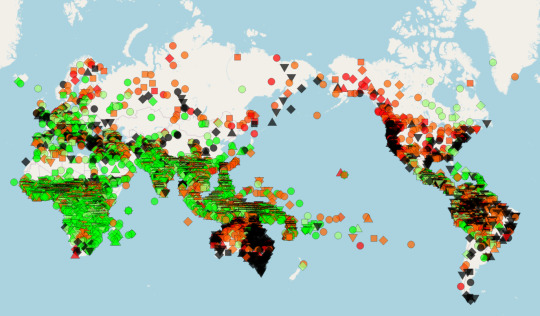
This map is also from glottoscope and can be found here. I recommend playing around with it, you can zoom in and hover over every dot to see which language it represents. The colours signify threat level: green for not threatened, light green for threatened, orange for shifting, red for moribound and nearly extinct, and black for extinct. I'll come back to the shapes later.
As you can see, language death is more common in certain areas, like Australia, Siberia, North America and the Amazon, but it's still spread over the entire world.
Why are languages going extinct?
There are two important dimensions to the vigorousness of a language: The first is the number of speakers who claim the language as their own and speak it with each other. No speakers means no language. If all speakers move to different places or assimilate by shifting to a dominant language in the area (sometimes for work opportunities or for their childrens' future work opportunities. Sometimes because of which language(s) schools are taught in or disinterest from the children in the language and culture. Sometimes migration of an ethnic group for various reasons leads to language shifts. There are many complex reasons to why the link of transmission can break)
The other dimension, which ties into the first one, is the number of situations in which a language is used. There are many domains a language can be used in, like at home, in school, in the workplace, in politics and administration, in higher education, for international communication, in religious activities, in popular media like movies and music etc. When a language is no longer or never used in a particular domain, it might lose the associated vocabulary. When it becomes confined to a singular domain like the home, the usage goes down. The home is usually the last place an endangered language is spoken.
Usage in a domain is a reason to speak or hear the language. It's a reason to keep it alive. People also forget or get worse at languages they don't use. That's why a common revitalisation tactic is producing movies, radio programmes, news reporting, books and other media in a dying language. It gives people both reason and opportunity to use their language skills. Which language is used in schools is also important, as it keeps basic vocabulary for sciences and explaining the world alive. Another revitalisation tactic is making up new words to talk about modern concepts, some examples are the Kaqchikel word rub'eyna'oj from this tournament or creating advanced math vocabulary in Māori.
What does endangered languages have to do with the average language?
Trying to get this post back on track, these are some key points:
64% of all documented languages are either extinct or facing some level of threat. That's the majority of all language
Even excluding the extinct languages, the majority of languages are threatened or worse
This means that the average language is facing a loss of speakers, some more disastrous than others. Being a minority language in an increasingly globalized world is dangerous
Describing a language
Are you able to look up words from your native language in a thesaurus or a dictionary? What about figuring out how a certain piece of grammar works if you're unsure? Maybe you don't need that for your native language, but what about a second language you're learning?
If your native language is English, there are lots of resources, like online and book dictionaries/thesauruses or an extensive grammar (a book about how English grammar works). There's also a plethora of websites and courses to learn English, and large collections of written text or transcribed speech. If a linguist wants to know something about the English language there's an abundance of material. If someone wants to learn English it's easy and courses are offered in most parts of the world.
For other languages, the only published thing might be a list of 20 words and their translation into English or another lingua franca.
Let's take a look at the same map as earlier, but toggled to show documentation status in colour and endangerment status with shapes:
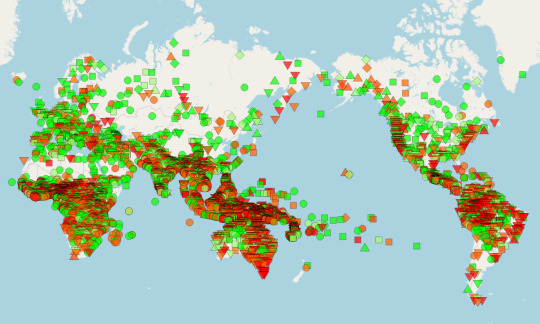
Here, the green signifies a long grammar and the light green a grammar. Both are extensive descriptions of the grammar in a language, but they differ in length. A long grammar has to contain over 300 pages and a grammar over 150. Orange is another type of grammar, namely a grammar sketch. Those are brief overviews of the main grammatical features or features that may be of interest for linguists, typically between 20 and 50 pages. The purpose isn't to be a complete grammar, only a starting point.
The red dots can signify a lot of things, but what they have in common is that there's no extensive description of the grammar. In those cases, the best description of the language might be a list of which sounds it contains, a paper about a specific feature, a collection of texts or recordings, a dictionary, a wordlist (much shorter than dictionaries) or just a mention that it exists.
Why are grammars and descriptions even important?
The better described a language is, the easier it is to learn it and study it. For a community facing language loss, it might be helpful to have a pedagogical grammar or a dictionary to help teach the language to new generation. If the language becomes extinct people might still be able to learn and revive it from the documentation (like current efforts with Manx). It also makes sure unique words or grammatical features as well as knowledge encoded in the language isn't lost even if the language is. It's a way of preserving language, both for research and later learning.
What's an average amount of descripion then?
36,2% of all documented languages have either a grammar or a long grammar. That's pretty good actually
38,2% of all documented languages would be marked by a red dot on this map, meaning that more languages than that don't have any kind of grammar at all, maybe only as little as a short list of words
The remaining 25,6% have a grammar sketch
So as you see, the well documented languages are in minority. On the brighter side, linguists are working hard at describing languages and if they keep going at the same rate as they have since the 1950s, they'll reach the maximum level of description by 2084. Progress!
Tying into both description of languages and domains where language is used...
What about technology and language?
There are many digital tools for language. Translation services, spelling and grammar checks in word processors, unicode characters for different scripts and more. I'm going to focus on the first two:
Did you know that there are only 133 languages on google translate? 103 more are in the process of being added, but that's still a tiny percentage of all languages. As in 2% right now and 3,5% once these other languages are added going with the 6700 language estimation.
Of course, this is for the most part a limination with translation technology. You need translated texts containing millions of words to train the algorithms on and the majority of languages don't have that much written text, let alone translated into English. The low number still surprised me.
There are 106 official language packs for Windows 10 and I counted 260 writing standards you can use for spelling checks in Word. Most were separate languages, but lots were different ways to write the same language, like US or British English. That's a vanishingly small amount. But then again:
Do all languages have a written standard?
No. That much is clear. But how many do? I'll just quote Ethnologue on this:
"The exact number of unwritten languages is hard to determine. Ethnologue (25th edition) has data to indicate that of the currently listed 7,168 living languages, 4,178 have a developed writing system. We don't always know, however, if the existing writing systems are widely used. That is, while an alphabet may exist there may not be very many people who are literate and actually using the alphabet. The remaining 2,990 are likely unwritten."
(note that Ethnologue classes 334 languages without speakers as living, since their definition of living language is having a function for a contemporary language community. I think that's a bad definition and that means it differs from figures earlier in the post)
Spoken vs signed
My last point about average languages is about signed languages, because they're just as much of a language as spoken ones. One common misconception is that signed languages reflect or mimic the spoken language in the area, but they don't. Grammar works differently and some similarities in metaphor might be the only thing the signed language has in common with spoken language in the area.
Another common misconception is that there's only one sign language and that all signers understand each other. That's false, signed languages are just as different from each other as spoken languages, except for some tendencies regarding similarity between certain signs which often mimic an action (signs for eating are similar in many unrelated sign languages for example).
Glottolog lists 141 Deaf sign languages and 76 Rural sign languages, which are the two types of signed language that become entire languages. The difference is in reach.
Rural signs originate in villages with a critical amount of deaf people (around 6) that make up a fully fledged language with complete grammar to communicate. Often large parts of the village learn tha language as well. There are probably more than 76, that's just the ones the linguist community knows of.
What's called Deaf sign languages became a thing in the 1750s when a French guy named Charles-Michel de l'Épóe systematised and built onto a rural sign from Paris to create a national sign language which was then taught in deaf schools for all deaf children in France. Other countries took after the deaf school model and now there's 141 deaf sign languages, each connected to a different country. Much easier to count than spoken languages.
Many were made from scratch (probably building on some rural sign), but some countries recruited teachers from other countries that already had a natinonal sign language and learnt that instead. Of course they changed over time and with influence from children's local signs or home signs (rudimentary signs to communicate with hearing family, not complete languages), so now there's sign language families! The largest one unsurprisingly comes from LSF (Langue des Signes Française, the French one) and has 63 members, among them ASL.
What does this have to do with average languages? Well, languages don't have to be spoken, they can be signed instead. Even if they make up a small share of languages, we shouldn't forget them.
Now for some final words
Thank you for reading this far! I hope you found this interesting and have learned something new! Languages are exciting and this doesn't even go inte the nitty gritty of how different languages can be in their grammar, sounds and vocabulary. Lots of this seem self evident if you think about it, but I remember how someone pointing out facts like this truly shifted my perspective on what the language situation in the world truly looks like. The average language is a lot smaller and diffrerent from the common idea of a language I had before.
Please reblog this post if you liked it. I spent lots of time writing it because I'm passionate about this subject, but I'd love if it spread past my followers
#linguistics fun fact time!#anyways can't believe this is finally done#i was going to make a series with informative posts between each round#and look what happened#i spent all my time writing this instead#hope you enjoyed!#and check out the linguistics fun facts tag#there are some more posts like this#linguistics
85 notes
·
View notes
Text

traditional style 💖
#akoya gero#gero akoya#cute high earth defense club love#binan koukou chikyuu bouei bu love!#boueibu#my art#my akoya wanted to join in the vintage dress-up party too!! \;;w;;/#ognvuhgh i wanted to have this done earlier bc other people were doing art so fast for the new outfits but it got dragged out#it was Mostly done a few days ago and i made final edits and was going to post it just before i rushed out to work#i put it up then i was like '??? wait there's a color blob in the wrong place i thought i fixed that???'#i was down to my last minute and didn't have time to do it so i was like auuuughhgh and took the whole thing down#on the Next day i opened the file again to see what was wrong and the color blob was NOT THERE#so im like ??? why did it suddenly appear again in the png. so i looked and i made an error in naming my files#i accidentally named one of the versions 30 instead of 03 so it sorted into the last place instead of the actual most recent version (07)#so that is the reason i ended up being 1 minute late to work. and the lesson to me is i should not try to post at the absolute last minute#(i say this but if i don't get smth done i can't stop thinking about it. it bothers me constantly to have something almost finished but not#(and then it's difficult for me to focus on other tasks so this is why i feel like i have to just get it done before i switch tasks)#anyway i wasn't totally sure what era the traditional outfits are supposed to be from. im not knowledgeable about fashion actually T.T#i googled 'when were suspenders popular' and ended up just looking at old photos and clothing patterns from the 30s-40s#photos from back then were black-and-white can you believe it.. you have to actually look at drawings and paintings to find color#everyone who left me messages elsewhere: THANK YOU SO MUCH!! \>/////</ i will reply soon!! \;;W;;/
40 notes
·
View notes
Text
“True Peace” and “Total Pacifism”: the Peacecraft Ideals & the Point of it All
(buckle up, this is a long one)
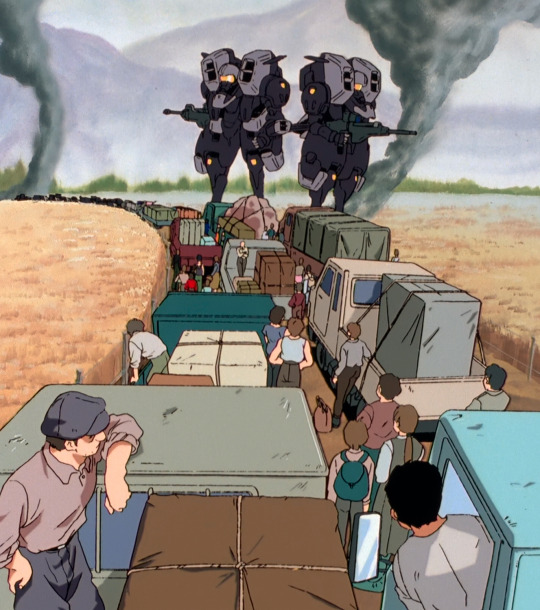
Capital “P” Peace is by far the most crucial concept in Gundam Wing.
It is a simple word that’s tossed around a lot and it pulls far too much weight for one little noun. The range of topics covered beneath this straining umbrella of a term includes everything from “a general sense of unthreatened well-being”, to “unilateral demilitarization and disbandment of global military rule”. The fault here lies not with translation difficulties or simplification for the ease of dubbing; real-world discussions of pacifism and peace are plagued by a lack of nuanced vocabulary as well. Alas, in this instance, it is the English language itself that has conspired to prank us.
Nevertheless, while overuse of the word is certainly frustrating at times, I find that when broken down and decoded, what may appear to be a lot of vague, flowery statements about the Virtues of Peace™ is actually a strategic political debate.
…Mostly. This is complicated somewhat by the fact that there are a significant number of characters for whom making flowery statements about the Virtues of War™ is a hobby and a way of life. So yes, indeed, sometimes convincing someone with Extreme Eyebrows that mankind can find value outside of eternal, violent conflict IS a priority that must be considered.
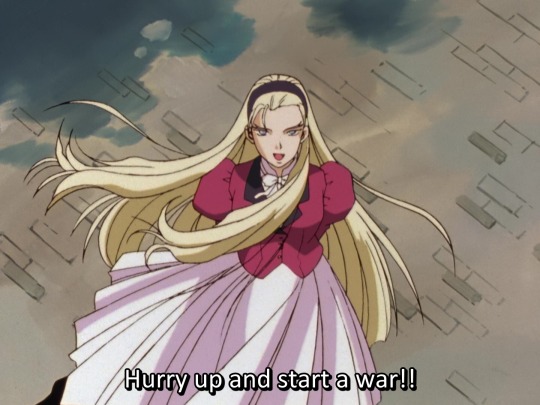
Part of why I think Gundam Wing had such a profound effect on its young audience when it came out is that it managed to cover most of an Intro to Ethics course in 49 episodes and a movie. It was a lot of kids’ first exposure to philosophy and politics, and it communicated its ideas by way of exciting robot fights and aspirationally cool characters. Gundam Wing made it easy to care about complex, abstract ideas and how they might affect the world– ideas that, at least for American audiences in the early 00’s, were well in advance of what they were likely to encounter in public school.
…Now, maybe you read that and found yourself thinking: “Come on, ‘peace is better than war’ is a pathetically simple dichotomy that no one needs to seriously debate”-- and I would love to give that to you. But as an American, I must beg you to consider that in the USA we have been trying to decide for decades whether an average of 75 school shootings per second is enough school shootings to consider implementing basic gun control.
Never underestimate the ability of a simple idea to become so polemicized that it becomes impossible to talk about or resolve without a total public paradigm shift– and now consider that learning how to cause a paradigm shift is exactly what Gundam Wing is all about.
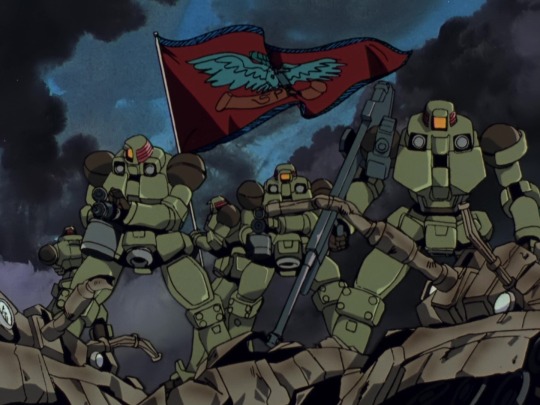
--There Is No War in A.C. 195--
For the majority of cases, when a character talks about war or peace, they mean specifically “between the Earth Sphere and the Space Colonies”-- as in, “an end to the conflict we have been embroiled in for roughly 20 years”.
This rather misleadingly makes it sound as though the Alliance is at war with the Colonies– but in AC 195, the Colonies do not have a military to go to war WITH. The Colonies aren’t engaged in a war with the Earth Sphere Alliance, they are under military occupation by the Earth Sphere Alliance.
When the Gundams first come to Earth and begin attacking the Alliance/OZ, the immediate question is: is this a declaration of war by the Colonies?
The burden continuously falls on the Colony ambassadors to prove that the Gundams are not politically associated with them. For all intents and purposes, they consider the retaliation of the Gundams to be acts of terrorism– which they must! Because otherwise they will indeed be at war with Earth, something the Colonies absolutely, 100%, definitively cannot afford. The Colonies are space bubbles. They can be popped. They can be blockaded. Earth provides the Colonies with the majority of their resources; declaring war against it would be insanity.
All this makes “peace with the Colonies” a very lopsided affair. Since officially speaking the Colonies have no military power, and since the nations of Earth that had previously allied with them were wiped out, negotiating for peace would require placing full trust in the Alliance. In other words, it would mean relying on the oppressor to stop oppressing purely as an act of goodwill.
This is why the “Peace Negotiations” proposed by the Alliance military leaders was at best a naive gesture that would have broken down at the first conflict of interest. The Alliance was responsible for the oppression of the Colonies to begin with– choosing to withdraw is a matter of their convenience; there is nothing to negotiate, because they have all the power. At worst, its “diplomacy” would simply be a farce designed to put a benevolent face on continued exploitation.
–Which is exactly what happens under OZ’s rule: “peace” is obtained in name only, while nothing about the power dynamic changes.
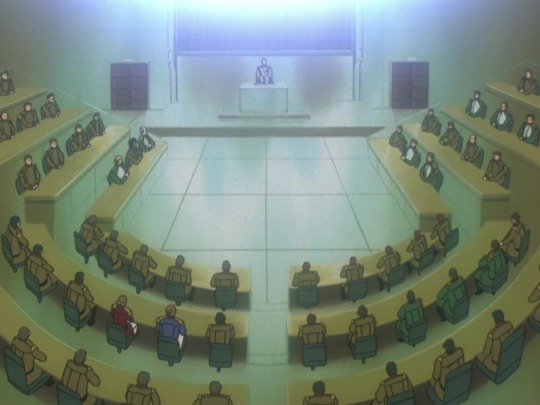
Here’s the trouble with settling for peace by any means: Every single military organization in Gundam Wing expresses a desire for world peace.
The Earth Sphere Alliance Military began as a peace-keeping measure. OZ claims it is correcting the Alliance’s failure to bring about world peace. Romefeller insists that it will bring about peace through a firm, authoritarian hand guided by the traditions of the ruling class. White Fang asserts that earth is responsible for all wars, and that peace can only be attained by destroying it.
There are many, many roads to “peace” that end in totalitarianism, to peace removed from liberty, to Pax Romefeller. In practice, White Fang’s approach would probably be the most effective at bringing about total, ever-lasting peace– if the result is all you care about, then sure, mass-extinction is one way to go!
But assuming we value peace because we ALSO value life and happiness and art and puppies and things like that, then we need to set the acceptable standard for peace somewhere above the eternal calm of a dead universe.
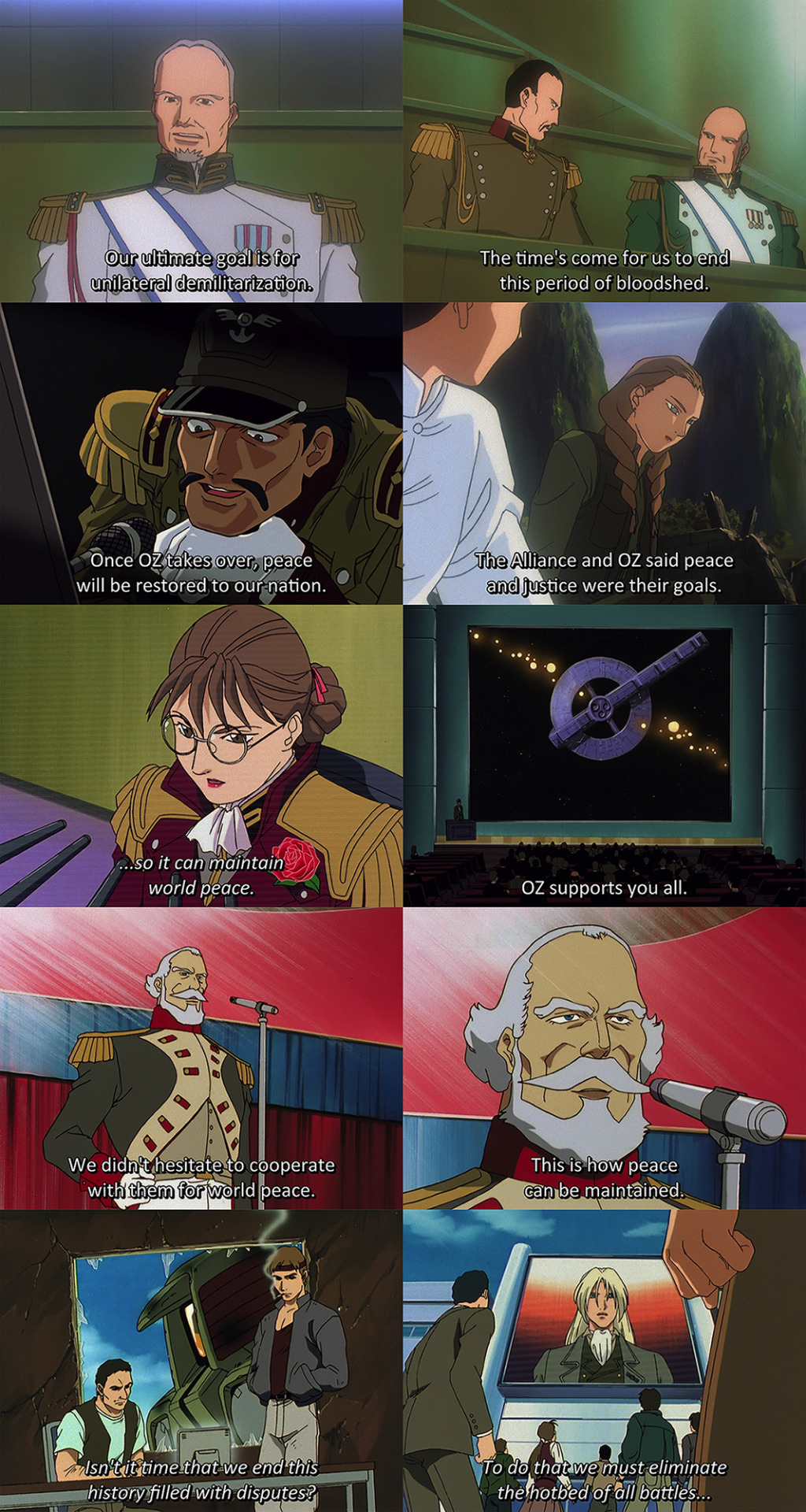
--The Peacecraft Ideals--
So, having established that “world peace by any means and any cost” is not a reasonable, humane, or moral outcome to strive for, we must consider “True Peace” to be a different outcome from “peace”.
As defined by Relena and ideals of the Sanc Kingdom, True Peace must be non-exploitative. It must require no threat of violence to enforce. To establish it, the means of military conflict must be removed and abolished, and the sources of human dispute must be addressed by means other than force of arms. Most importantly, True Peace requires fostering a transformational attitude towards peace– one that empowers the collective will of the people to both achieve and maintain peace.
To summarize, the Peacecraft plan of action is: 1) Remove weapons that are the means of military conflict, 2) Remove the primary sources of military conflict, and 3) unite people in the desire for peace, and to uphold peace.
It’s this last point that is so crucial to events that the entirety of the final narrative arc hinges upon answering the all-important questions: how does one foster the desire for peace, and bring about a massive paradigm shift that can change the course of history? and what price is one willing to pay for it?
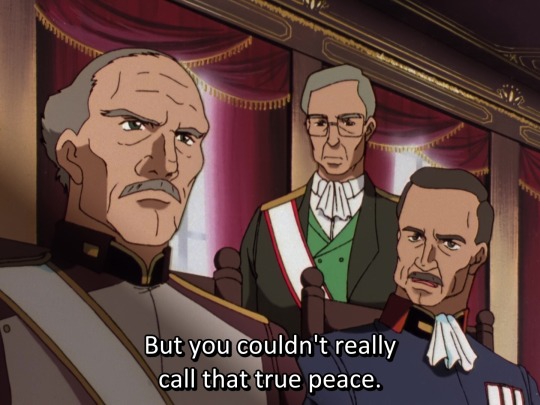
“Absolute pacifism [which is understood as a maximal and universal rejection of violence and war,] is an ideal. Some versions of absolute pacifism go so far as to abjure the idea of personal self-defense. Other absolute pacifists may allow for personal self-defense while rejecting the impersonal and political violence of war. Almost every defender of absolute pacifism recognizes the difficulty of attaining the absolute ideal.” “The world often presents us with difficult ‘kill or be killed’ choices as in the question of self-defense or war. Absolute pacifists may hold that it is better to be killed than to kill. But such a choice may be impossible for many of us to make. Pacifists will often argue that this way of describing a situation—as one where the choice is ‘kill or be killed’—usually presents us with a false dilemma: often there are other nonviolent alternatives to either killing or being killed. But when presented with such a stark choice, absolute pacifism may require self-sacrifice.” --“Pacifism”, Stanford Encyclopedia of Philosophy, Andrew Fiala, 2006
--Pulling back to real-earth for a moment: there is a wide and continuous spectrum of ethical, religious, political, and practical attitudes to be found spanning the distance between Absolute and Conditional forms of pacifism, but despite its similar name, the Total Pacifism of Gundam Wing is not a synonym for Absolute Pacifism:
There is no indication that Relena is against self-defense, nor that she insists on absolute non-violence; she’s a staunch defender of the Gundam pilots, after all, and they’re practically the face of violent resistance. She admits that in past history there were conflicts that could not have been avoided, and that one cannot maintain civilization without some degree of enforcement of principles. We can safely assume (especially after her change of heart in Endless Waltz) that she supports the proportional defensive reaction of people who are resisting oppression. But killing people is not, or at least very rarely, justifiable in her worldview (allowing for the fact that both Relena’s character and her philosophy evolve over the course of the series), and warfare never is.
“Peaceful intercourse is easily rejected by those who assert the benefits of the martial values, who claim that a war brings out the best of people and of a society, that wars heighten humanity s perception of itself in the great existentialist quest between life and death, that war relieves the monotony of consumerism and so on. This highlights one of the most difficult aspects of pacificism, that the goal of peace and of tranquility may not suffice human nature. The persistent nagging of bellicosity, of adventure, personal and collective glory, whether it derives from something genetic or culturally deeply embedded in most societies, remains an easily revitalized clarion call to war. The culture of peace is often very shallow, taking many generations to produce, and even then can be swiftly eroded with atavistic rhetoric.” --“Pacifism”, Internet Encyclopedia of Philosophy, Alexander Moseley
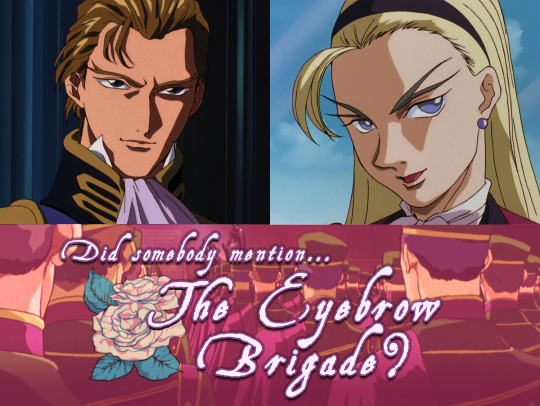
(...Remember what I said about needing to convince certain people that mankind can find value outside of eternal warfare?)
Relena’s Total Pacifism is primarily an anti-military political stance; it is only secondarily a philosophy of nonviolence. Over the course of the series, Relena confronts over and over again the notion that many people are drawn to the act of fighting for various reasons, ranging from the vindictive to the instinctual. It is not an impulse she shares or understands, but she recognizes that it exists. She is ready to admit that even within Total Pacifism, a world totally without violent desires may be impossible– but it is not necessary that people accept a world where those desires give rise to military conflict.
–Something that is worth noting is that the Peacecraft’s plan for total pacifism does not include a rubric for solving conflicts that do arise, only how they should NOT be solved.
In the series, the single method that Relena espouses for solving disputes is through “dialogue”-- something that is repeatedly pointed out to be a flawed and inadequate form of conflict resolution. “Dialogue” cannot solve all of humanity’s problems, that is unquestionably true– but neither is it a bad place to start as a baseline. More to the point, of all the possible conflicts and struggles that humanity might encounter in the vast expanse of the future, it’s futile to try and codify the best method of solving all of them based purely on abstract theory and best guesses.
Again, the Peacecraft ideal is only secondarily a philosophy; its primary goal is not to tell people HOW to solve all future problems, its goal is to solve ONE problem, and that one problem is war.
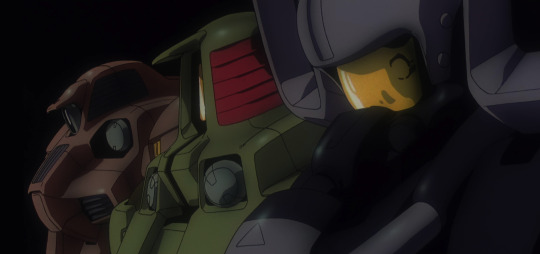
“Disarmament” Means Mobile Suits
Removing the possibility of military conflict is a preliminary for Total Pacifism, and therefore it is necessary to implement universal disarmament– and “disarmament” as it pertains to the conflicts of AC 195 means primarily the discarding and prohibition of Mobile Suits.
The reason for this is not simply because Mobile Suits are dangerous weapons. After all, Mobile Suit warfare is hardly the biggest or baddest type of war the human race has developed– leveling a city with Mobile Dolls couldn’t possibly be worse for people than leveling a city with an atomic bomb– the main thing Mobile Suits allow people to do is fight wars using infantry in space.
Not only do Mobile Suits allow for space combat, they also grant very granular control of combat zones and civilian populations without substantial risk to the troops– which is great if you’re trying to enforce military rule in the Colonies. Space fortresses and missile satellites are also threats of course, but where a missile attack would simply destroy or damage a Colony, Mobile Suits allow military forces to take direct control of it, the area around it, its resources, its populace; everything, inside and out. This is why disarmament of MS has to be a primary concern for de-escalating conflict between Earth and the Colonies: as long as Mobile Suits are still in the picture, the potential threat of domination by the Earth Sphere remains, and nobody in the Colonies is going to relax.
The Other Pacifists of A.C. 195
“Law never made men a whit more just; and, by means of their respect for it, even the well-disposed are daily made the agents of injustice. A common and natural result of an undue respect for the law is, that you may see a file of soldiers, colonel, captain, corporal, privates, powder-monkeys and all, marching in admirable order over hill and dale to the wars, against their wills, aye, against their common sense and consciences, which makes it very steep marching indeed, and produces a palpitation of the heart. They have no doubt that it is a damnable business in which they are concerned; they are all peaceably inclined. Now, what are they? Men at all? or small movable forts and magazines, at the service of some unscrupulous man in power? […]The mass of men serve the State thus, not as men mainly, but as machines, with their bodies. They are the standing army, and the militia, jailers, constables, posse comitatus, &c. In most cases there is no free exercise whatever of the judgment or of the moral sense; but they put themselves on a level with wood and earth and stones; and wooden men can perhaps be manufactured that will serve the purpose as well.” —“On the Duty of Civil Disobedience”, Henry David Thoreau
The Sanc Kingdom is not the only proponent of pacifism in the Earth Sphere.
In the Autonomous Mountain Region of former China (helluva mouthful, you'd think they'd have given themselves an actual name), for instance, we’re shown another civic leader who gathers support for demilitarization and objects to Alliance occupation. Like the Colony leader Heero Yuy and King Peacecraft before him, this unnamed leader is assassinated, and his independent nation taken over by the local branch of the Alliance military.
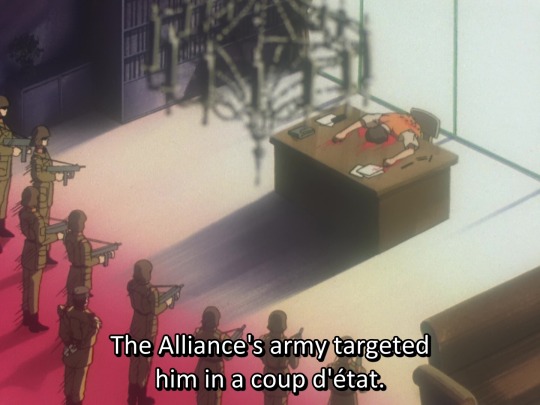
It’s only a brief footnote in the series, but it’s important because it demonstrates that the dream of pacifism is not dead on Earth, despite how often it has been violently silenced by the prevailing world order. It speaks to how powerfully the message spread by Yuy and the Sanc Kingdom resonated with people that their ideals continue to generate new martyrs; we see it also in the nations surrounding the Sanc Kingdom who are willing to stand up against Romefeller and refuse to participate in military affairs.
The existence of these nameless “Autonomous Regions” and “Independent Nations” shows us that there is at least some degree of successful resistance against the Earth Sphere government (whether that be the Alliance or OZ); it’s also clear by statements from Duke Dremail that these independent entities are considered a tremendous threat.
In a system of global military rule, to renounce the military is to essentially declare one’s withdrawal from the existing government– something that surprisingly doesn’t elicit immediate reprisal under Romefeller’s oligarchy, at least when the seceding nations offer no armed resistance.
But the rise of pacifistic nations on earth is nevertheless regarded with as much suspicion and hostility in A.C. 195 as it was during the Sanc Kingdom’s first bid for Total Pacifism, and while Romefeller, unlike the Alliance, is either unwilling or lacks the unilateral authority to quash dissenters without justification, it is more than willing to manufacture justifications to remove political rivals from the playing field. But what’s important is that they still need that manufactured justification– Romefeller, like any authority structure, requires a certain level of assent and cooperation in order to maintain power.
The practical implication of multiple countries withdrawing from the Earth Sphere and/or refusing to support the global military, is that the Earth Sphere government has fewer nations to tax and draw on for resources or support, and more places where rebel elements can take refuge. In the long run, a sufficient number of simultaneously defecting nations could mean the collapse of global military rule itself.
Armies and weapons and soldiers don’t spawn automatically on a map. Everything has to come from somewhere, and a global military organization needs to be supplied and maintained by the globe.
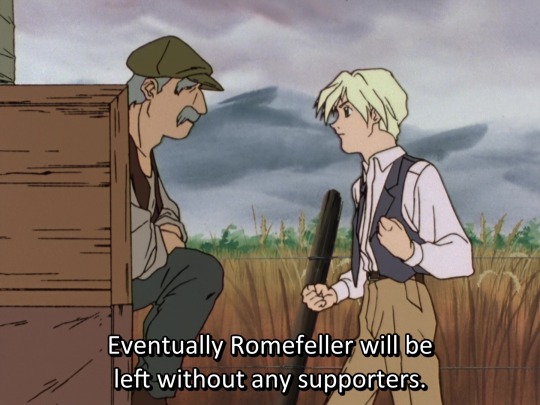
Whatever the Alliance’s policies were, it’s safe to assume that OZ/Romefeller inherited and maintained many of them, partly because they were always part of the decision making process, and also because hey, why let a perfectly good global bureaucratic infrastructure go to waste? The Alliance began as a cooperative global peace-keeping initiative; at its root, it was developed from international bureaucracy, rather than an imposed dictatorship. Even after it became the dominating world government, that underlying bureaucratic structure surely remained to some extent. National borders were still recognized, at least as an organizational convenience; the Alliance relied on taxes from the various recognized nations under their control (including the Colonies), as well as the heavily-incentivized funding of the arms industry, tied to the wealthy estates of the Romefeller Foundation, many of whose members were leaders or rulers of different nations themselves. It’s also likely there was some sort of draft for citizens of the Earth Sphere and the Colonies.
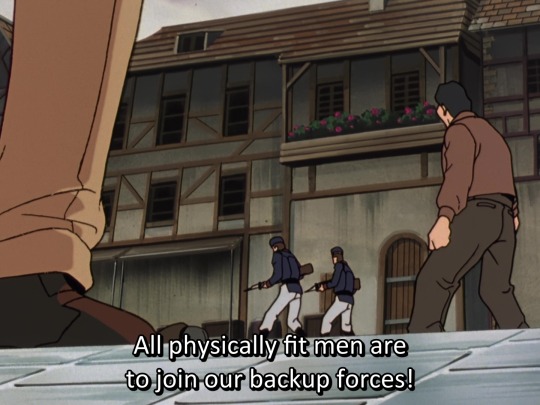
Why does this matter? Because in non-violent resistance, particularly in civil disobedience and non-compliance, it’s necessary to find ways to gain leverage that don’t involve offensive combat. In the case of resisting a military oppressor, learning what conditions allow the military to continue operating, and how to disrupt that operation, is of key importance.
Outside of Earth, we’re shown another notable example of disruptive resistance from the Winner family– adamant pacifists themselves, though their sole male heir, Quatre, broke with tradition and chose to fight against OZ using the Gundam Sandrock. The Winner family is in charge of several major natural resource satellites, a primary source of supplies for the adjacent Colonies. When those Colonies allied themselves with OZ and began arming themselves in spite of their past commitment to pacifism, and in spite of OZ’s quite recent manipulative and violent suppression of the Colonies, the Winner family patriarch protested this move vehemently. When it was clear the now-militarizing Colony would continue supporting OZ and intended to begin manufacturing weapons on the natural resources satellite, Mr. Winner removed his support from the Colony– both ideologically and physically, by decoupling the resource satellite; a move that cost him his life at the hands of OZ.
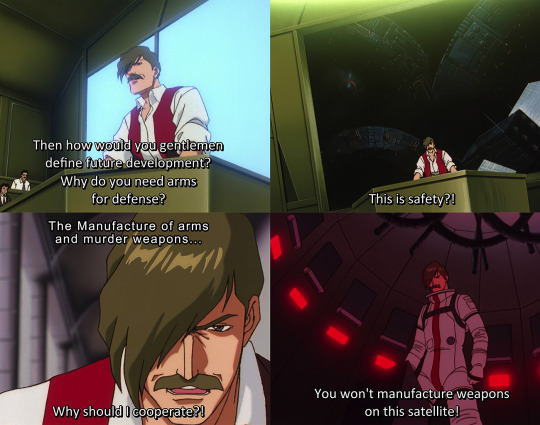
A Glass Kingdom Throws No Stones
The Sanc Kingdom’s existence is based on hope.
It assumes peace (i.e. a state of goodwill and non-conflict) is the natural state humanity longs for, the only condition it can truly flourish in, and therefore it is in everyone’s best interest to pursue. Even those who advocate in favor of war would eventually see the pragmatic benefit of peace– wars are costly, and demand a constant supply of resources and humans to throw into it. If everyone simply acknowledged these truths, True Peace ought to be the inevitable outcome.
This position is largely (but not universally) viewed as naive, idealistic, and ultimately hopeless. Even its proponents acknowledge that the Sanc Kingdom’s ideals are built on trust and air– but they maintain that their belief in that trust is nevertheless of utmost value, for inspiring others to realize what might be possible if that trust were universal.
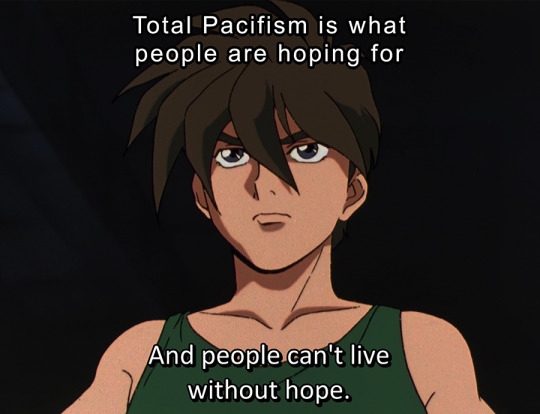
The Sanc Kingdom’s one defense is its total lack of offense. By removing itself as a potential threat and offering no resistance or antagonism to the ruling power, it minimizes the incentive for that ruling power to overrun and destroy it– but there are no guarantees.
Relena pragmatically warns her students that the Sanc Kingdom will never be a safe place until Total Pacifism is adopted globally. She herself is prepared for the likely scenario that advocating for peace will cost her her life. The tenuousness of the kingdom’s position is fully acknowledged by all– how could it not be? The current Sanc is built on the ruins of the previous generation’s bid for pacifism.
Despite this, the kingdom’s doors are open to all; Relena maintains a supremely generous view of mankind that gives everyone the benefit of doubt, continuing within the same logic that non-aggression will be met with non-aggression. Perhaps more accurately, this policy is her way of insisting that this is how peaceful interactions ought to be; despite the considerable risk they incur, both she and her kingdom stand defenseless in a world of grasping military powers, wielding only her dignity, her public visibility, and a conviction that everyone is capable of choosing respectful conduct.
The Sanc Kingdom is perfectly set up for martyrdom– and it is a very short ride before it gets there.
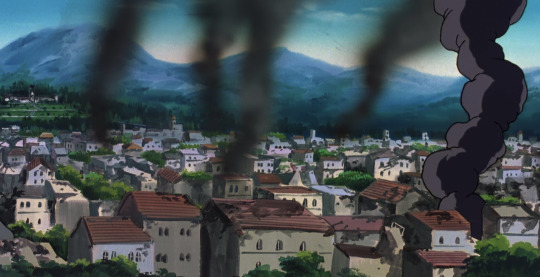
But the power of Relena’s ideals is not tied to the existence of the Sanc Kingdom– it’s not even tied to her, or the Peacecraft name. The naivety, the impossibility, of pacifism in an era defined by global military rule, is constantly reiterated, and yet it does not disappear.
Even as the bottleneck of war grows tighter and the violence between the ever-fragmenting world powers continues to escalate, the majority of people bearing witness to these horrors look to an alternative that offers hope, as practiced and advocated by a brave girl facing impossible odds.
The more pitched the violence becomes, the louder its perpetrators shout that peace is impossible, while to the people suffering its effects, the more outrageous and unnecessary that violence is revealed to be. The ones waging the wars seem to be the ones generating new reasons for them, their excuses becoming increasingly absurd, their justifications transparently thin.
Is it really so absurd or unreasonable by comparison, to take part in an actionable plan for peace?
“I’m aware that my views may appear to be a little naive to some people, but I wonder why people battle if everyone agrees that it’s foolish to do so? I don’t think that we’re too far from the answer.”
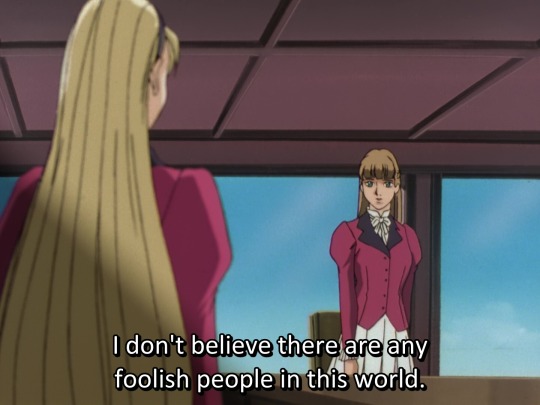
#Gundam Wing#Relena Peacecraft#Sanc Kingdom#After Colony#Gundam Wing Meta#Dorothy Catalonia#Romefeller Eyebrow Brigade#gundam wingtionary#wing watcher's toolkit#parsing post#i can't believe this entry is finally done hallelujah i'm free
88 notes
·
View notes
Text
Y'all I am SHAKING right now
After three years of trying, I've finally beat the Pantheon of Hallownest in Hollow Knight. I have NEVER done that before and am absolutely shook in a good way
#hollow knight#pantheon#pantheon of hallownest#THREE YEARS#that's how long I've been playing the game#I always lost to markoth#or pure vessel#or the radiance itself#I can't believe I've finally done it#text#text post#messages from Muffin
6 notes
·
View notes